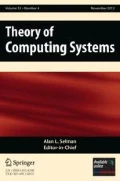Abstract
Consider a situation where people have to choose among a sequence of n linearly ordered positions to perform some task requiring a certain amount of privacy. Which position should one choose so as to maximize one’s privacy, i.e., minimize the chances that one of your neighboring positions becomes occupied by a later arrival? In this paper, we attempt to answer this question under a variety of models for the behavior of the later arrivals. Our results suggest that for the most part one should probably choose one of the extreme positions (with some interesting exceptions). We also suggest a number of variations on the problem that lead to many open problems.
Similar content being viewed by others
References
Flajolet, P.: A seating arrangement problem. http://algo.inria.fr/libraries/autocomb/fatmen-html/fatmen1.html
Freedman, D., Shepp, L.: An unfriendly seating arrangement problem. SIAM Rev. 4, 150 (1962)
Friedman, H.D., Rothman, D.: Solution to an unfriendly seating arrangement problem. SIAM Rev. 6, 180–182 (1964)
Georgiou, K., Kranakis, E., Krizanc, D.: Random maximal independent sets and the unfriendly theater arrangement problem. Discrete Math. 309, 5120–5129 (2009)
Hoffman, L.: Computers and privacy: a survey. ACM Comput. Surv. 1, 85–103 (1969)
Kleinrock, L.: Queueing Systems, Volume 1: Theory. Wiley, Hoboken (1975)
MacKenzie, J.K.: Sequential filling of a line by intervals placed at random and its application to linear absorption. J. Chem. Phys. 37, 723–728 (1962)
Munroe, R.: Urinal protocol vulnerability. http://blog.xkcd.com/2009/09/02/urinal-protocol-vulnerability/
Paola, C.: A survey of obnoxious facility location problems. TR-99-11, University of Pisa, Dept. of Informatics (1999)
Ross, S.M.: Stochastic Processes, 2nd edn. Wiley, New York (1996)
Vogt, R., Nascimento, M.A., Harns, J.: On the tradeoff between user-location privacy and queried-location privacy in wireless sensor networks. In: AdHoc Now 2009, pp. 241–254 (2009)
Author information
Authors and Affiliations
Corresponding author
Rights and permissions
About this article
Cite this article
Kranakis, E., Krizanc, D. Maintaining Privacy on a Line. Theory Comput Syst 50, 147–157 (2012). https://doi.org/10.1007/s00224-011-9338-3
Published:
Issue Date:
DOI: https://doi.org/10.1007/s00224-011-9338-3




